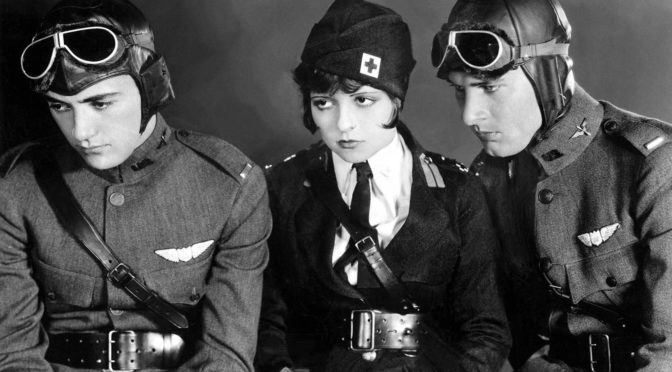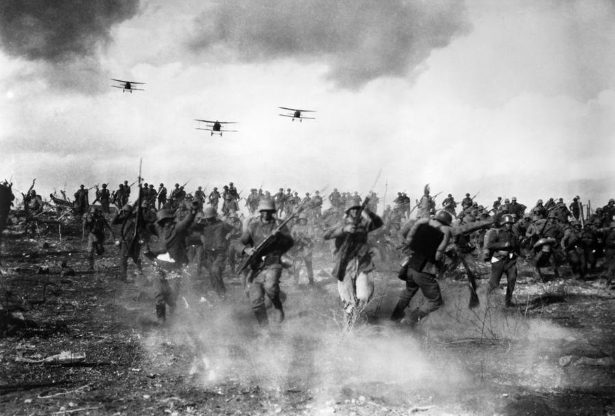Welcome to Every Best Picture, yet another new feature here at GAMbIT, wherein I will watch and write about every film to ever win the Academy Award for Best Picture. I won’t keep myself to a one-a-day schedule, or even one-a-week, because that’s what drove me to near madness during 31 Days of Fright. New EBP entries will be posted at whatever frequency I choose, but I’ll try not to make the postings too sporadic, because I know a lot of you are champing at the bit to read my take on 1956’s Around the World in 80 Days. Let’s get started.
Best Picture: Wings
The Other Nominees: The Racket; 7th Heaven
Film historians, or fans of German impressionism, will tell you that Wings actually shared the first Best Picture Oscar with F.W. Murnau’s Sunrise (which was awarded for “Unique and Artistic Production”). Retroactively, the Academy decreed that the Oscar belonged solely to Wings, and it’s easy to see why. In the 1920s, films were so goddamn difficult to make that everyone either made Three Stooges shorts or grand, sweeping epics like Metropolis. Wings fits firmly in the latter category. The scope of this film is incredible, even today, and a surprising amount of it holds up.
To put the plot in its simplest terms, Wings is about two aspiring fighter pilots, Jack Powell (Charles “Buddy” Rogers) and David Armstrong (Richard Arlen), both of whom are in love with Sylvia Lewis (Jobyna Ralston); Jack is also oblivious that his neighbor Mary Preston (Clara Bow) is in love with him (Mary is first shown as a charming nuisance; a funny title card says that Jack once pulled her from a bonfire, and “sometimes regretted it”). If you’ll let me spoil a million-year-old movie, Sylvia never registers as anything more than a plot device, and even in a silent movie Ralston’s performance is lacking. But that’s easy to understand when the other female lead is Clara Bow, who was the “it” girl of the 1920s. Picture a boring unknown trying to act opposite Jennifer Lawrence and you’ll get the idea.
Bow has charisma to spare, and has a girl-next-door beauty that makes her lovable but also unassuming. To use a hoary cliché, she lights up the screen, and although Arlen and Rogers do fine work as David and Jack, they can’t compete with Bow’s presence.
Make no mistake, though: Arlen and Rogers acquit themselves nicely. Granted, they’re hard to tell apart sometimes, but Jack and David’s friendship is the cornerstone of Wings. They enter aviation training as enemies, but gradually become friends and save each other more than a few times. As the flowery title cards suggest, Wings was produced at the height of Hollywood melodrama (one card refers to Jack and David being “on furlough from death”), yet Jack and David’s relationship never feels anything less than realistic, and it does a better job of anchoring the film than any of the loves stories. It’s a testament to Wings‘ confident storytelling, William A. Wellman’s direction, and Arlen and Rogers’ skill.
Their relationship is also emblematic of the main thrust of Wings. There’s an undercurrent of decency, respect, and civility throughout the film, shown in several quietly beautiful scenes. When Jack drops his locket with Sylvia’s picture in it (it was meant for David, but Jack saw it first), David offers to put the picture back in so Jack won’t see the loving inscription that Sylvia wrote to him. When a German fighter is shot down, the French military pull his body from the wreckage and carry him on their shoulders. An American recruit named Herman Schwimpf is constantly derided for his Germanic last name, but becomes respected and admired by his peers. World War I had been over for nine years by the time Wings came out, and the basic decency evinced by its characters is a nice effort by Wellman to portray the Germans as human.
The centerpiece of Wings, though, is battle sequences, and they’re quite frankly stunning. There’s something magical about movies this old; when you see an army on screen, you know there was an army in front of the camera (Wings utilized 3,500 extras). The sense of grandeur here is undeniable, especially in the aerial dogfights. Wellman was himself a pilot in WWI, and the battles in the sky have a sense of immediacy you can’t get from computer-generated images; you have to mount a camera on a plane and film it live.
Wings isn’t a perfect film, though. In my opinion, any movie that runs two and a half hours has to work really hard to justify its runtime, which films like The Dark Knight or There Will Be Blood do with aplomb. But Wings could have used a heavier hand in the editing room. Some sequences drag on seemingly without end, such as a fight between Jack and David, or a drunken Jack fixated on bubbles in a Parisian nightclub. The script sometimes tends towards hero worship of its two main characters, down to an impromptu parade through Paris, but I admire it for being so generous towards Mary, who gets an unusual amount of agency for a female character from this day and age (she drives a truck for the Army).
In the end, it’s hard to recommend Wings unreservedly, because, well, it’s two and a half hours long and silent. But I think it’s worth checking out, if you have the time, patience, and inclination. At a time when the language of film was just being written, it’s pretty incredible to see a film get so much of it so right.
Next Up: The Broadway Melody




One thought on “Every Best Picture: Wings (1927/28)”
Comments are closed.